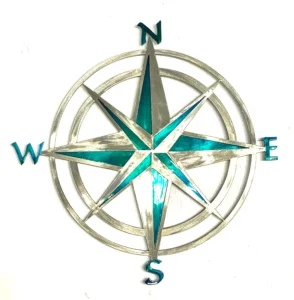Compass Rose: In the vast tapestry of navigational history, the compass rose stands as an iconic symbol of direction and exploration. Its intricate design has guided sailors and adventurers for centuries, but who can be credited with its creation? Join us on a journey through time as we unravel the enigma of the compass rose and explore seven captivating facts about its design.
1. Ancient Origins
The compass rose has ancient roots that date back to the early days of maritime exploration. While its exact inventor remains elusive, evidence suggests that early compass roses emerged during the Roman era. Mariners relied on rudimentary versions of this navigational aid to enhance their understanding of wind directions and cardinal points.
![]()
2. Portolan Charts Influence
During the medieval period, the compass rose underwent a significant transformation with the advent of portolan charts. Skilled cartographers integrated these roses into their maps, utilizing them to depict wind roses and navigational details. This marked the beginning of the compass rose as an integral component of cartography.
3. Ptolemy’s Contribution
The renowned ancient Greek geographer, Claudius Ptolemy, made invaluable contributions to the development of the compass rose. His influential work, “Geographia,” provided detailed insights into mapmaking and navigation, influencing the integration of the compass rose into maps during the Middle Ages.

4. Evolution of Design
Over the centuries, the design of the compass rose evolved, becoming increasingly intricate and aesthetically pleasing. Elaborate patterns and ornate embellishments adorned compass roses, reflecting the artistic tastes of different eras and cultures.
5. Symbolism and Meaning
Beyond its practical use in navigation, the compass rose carries rich symbolism and meaning. Often featuring cardinal points, intercardinal points, and half-winds, the design represents a comprehensive guide to directional awareness. Additionally, some compass roses incorporate symbols and imagery related to maritime folklore and mythology.
6. Nautical Instruments Integration
As technology advanced, the compass rose found its way onto various nautical instruments. Astrolabes, sextants, and other navigational tools incorporated compass roses, enhancing their functionality and aiding sailors in precise navigation across vast oceans.

7. Contemporary Significance
In the modern era, the compass rose retains its relevance in navigation, albeit often in digital form. GPS systems and electronic navigation devices frequently incorporate a virtual compass rose, paying homage to the historical significance of this timeless navigational tool.
In conclusion, the story of the compass rose is one of enduring mystery and innovation. From its ancient origins to contemporary applications, this navigational symbol continues to guide us through the intricate web of exploration and discovery. As we delve into the past, we gain a deeper appreciation for the craftsmanship and ingenuity behind the creation of the compass rose.
OTHER TRENDING ARTICLES OF THE DAY:
WRITTEN BY RODGERS

